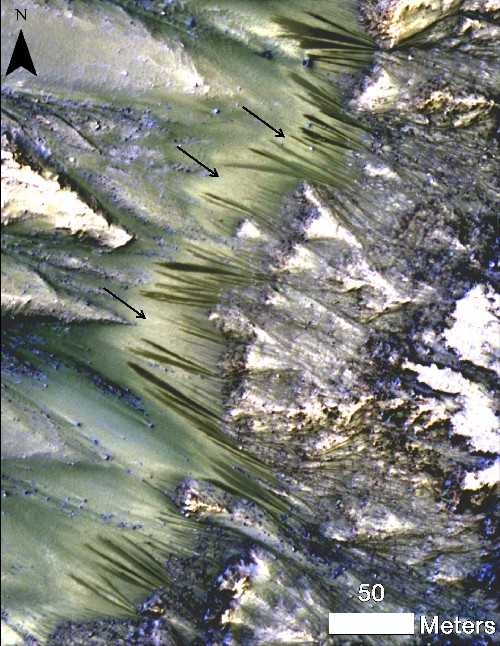| Online: | |
| Visits: | |
| Stories: |
New Evidence Points To Liquid Water Flowing On Mars (Video And Photos)
Tuesday, February 11, 2014 4:13
% of readers think this story is Fact. Add your two cents.
(N.Morgan) A recent discovery of liquid water flowing on Mars was found is is still flowing today, a claim that could debunk the long held belief that mars was a dry planet for millions of years. Lujendra Ojha and a number of his fellow academics at the Georgia Institute of Technology have proposed that the dark, finger-shaped features on Martian slopes which disappear and reappear as seasons change are in fact flows of saltwater. The dark lines are officially known as recurring slope lineae (RSL), and NASA has previously confirmed that the markings are most visible when temperatures rise. Ojha, a graduate student, published the details on 13 RSL sites in the journal Geophysical Research Letters. The images he examined were captured by the HiRISE camera on NASA’s Mars Reconnaissance Orbiter.
“We still don’t have a smoking gun for existence of water in RSL, although we’re not sure how this process would take place without water,” Ojha said in a statement issued by NASA. “In HiRISE images, we see them forming, elongating and then fading over time. That’s why they’re called seasonal – they form and flow when the temperature is right.”
What the images do confirm is that iron-containing minerals were found on the slopes where water is suspected. Other slopes, where the dark finger-shapes were not found, do not contain iron minerals. “Just like the RSL themselves, the strength of the spectral signatures varies according to the seasons,” Ojha explained. “They’re stronger when it’s warmer and less significant when it’s colder.”


(Images)
More Stories:
FEMA 800 Detention Camps In USA – Last Days Final Hour News Up (Startling Video)
Earthquakes And HAARP (Video)
How Willful Blindness Keeps Everyone Living A Lie (Video)
Represent.Us – Uniting To End Government Corruption (Video)
Read The Memo Explaining Why The U.S. Can Totally Kill Its Own Citizens Without Trial (Video)
Low-Cost Survival Hygiene: Making Lye Soap From Fat And Wood Ashes (Video)
Get Obamacare Or Go To FEMA Camp 2014 (Video)
Guess What? You’re The Enemy (Video)
SWAT Team Commandeers Woman’s Home During Standoff With Neighbor: “You All Need To Leave, You Can’t Be In Your House” (Video)
HAARP Super Stable Plasma Cloud – (Video)
More Stories Contributed By N. Morgan
Also featured at:
AlternativeNewsToMe1 – Blogspot
AlternativeNewsToMe1 – WordPress






Dear BIN;
It is usually proposed that the gullies on Mars were carved by water. However water is not the only liquid in the Universe. See below for an alternate hypothesis.
I suspect that you will find a hypothesis interesting that the gullies and canyons of Mars are carved by rivers of silicone dust (or liquid) useful, as described in; http://charles_w.tripod.com/mars.html If this hypothesis is valid there must surely be vestiges of those ancient silicones still present in some of the sediments and maybe even in some of the soils. They may be the source of the methane detected in the Martian atmosphere. If any of the “sediment” particles are seen to float on water, it would be strong circumstantial evidence for silicone presence. It is also possible that there are remnants present in Meteorites from Mars. If you find any, please let me know.
It is conceivable that residual silicone coatings making soil unstable to meteorite impact could account for the recent debris flows that have been described.
I suspect that you will also find interesting a proposal of my son’s that huge meteorites cause a disruption on the opposite side of a planet. This proposal to explain the bulges and volcanoes on one side of Mars may be seen in http://charles_w.tripod.com/dweber/mars_volcanos/mars_volcanos2.html . My version of this phenomenon here on Earth may be seen here; http://charles_w.tripod.com/antipode.html .
Sincerely, Charles Weber